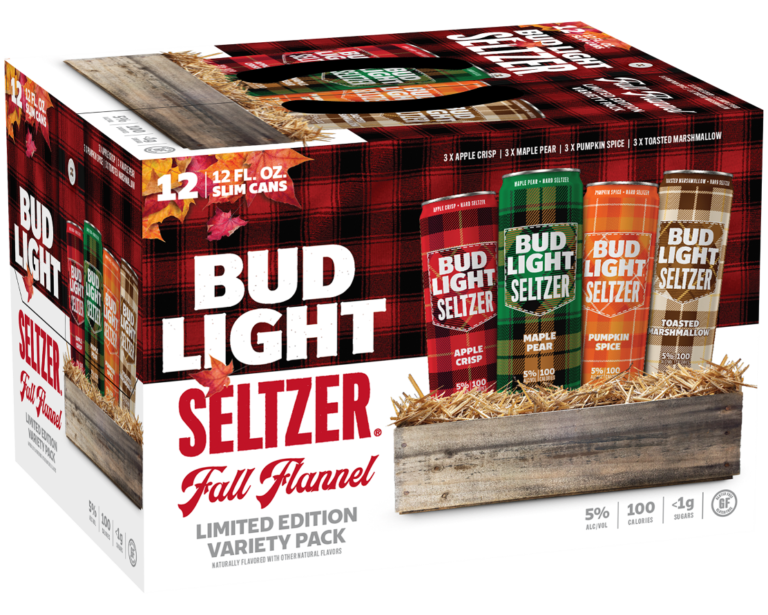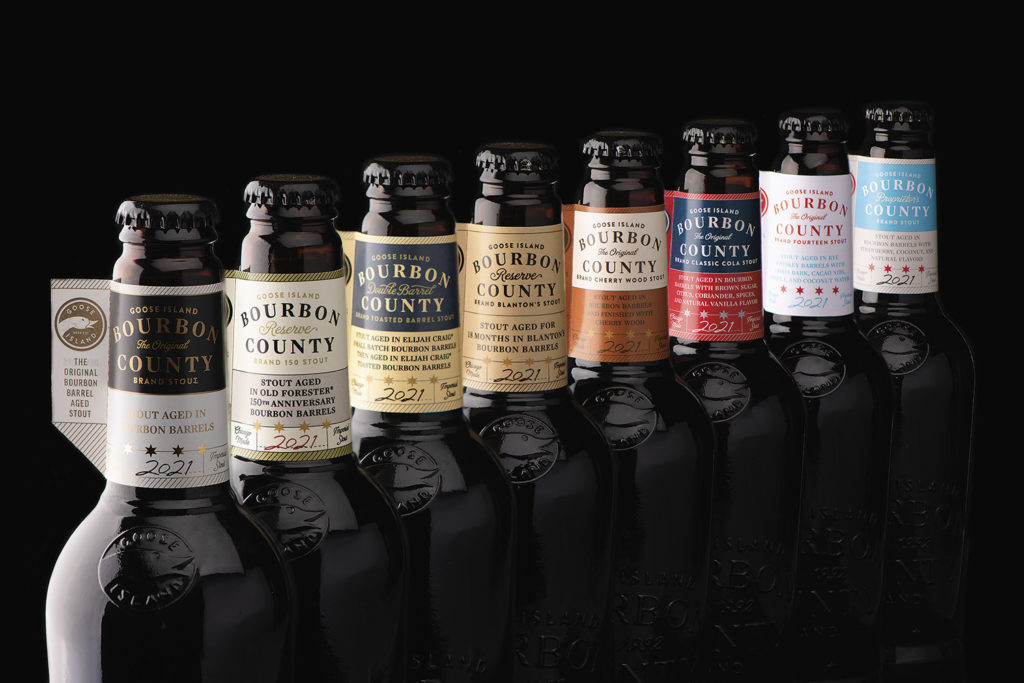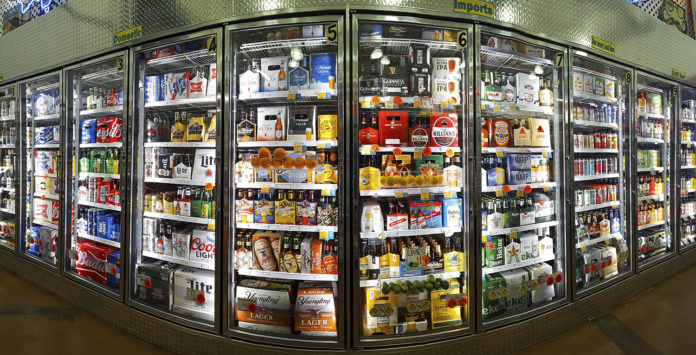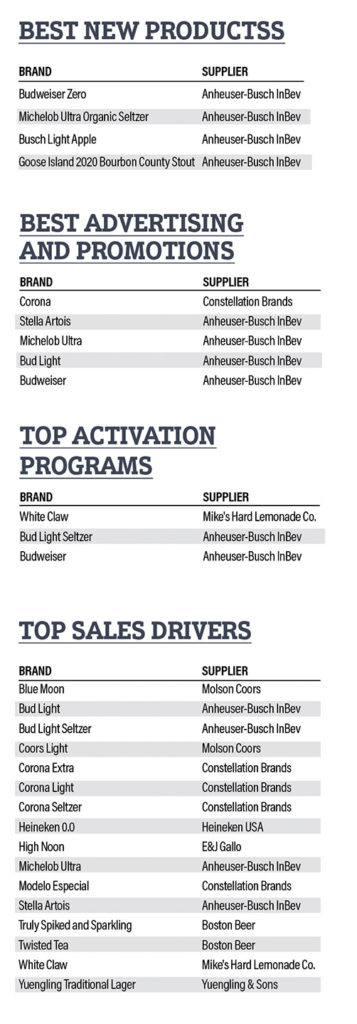Our annual Beer Growth Brands Awards reflect the top beer trends from the past year while also looking ahead.
What can we learn from 2020 and 2021 as we move forwards? The unusual severity of Covid-19 makes it difficult to derive too much from our recent past to inform our future. How can we draw hard lessons from a once-in-a-generation pandemic?
Still, trends that emerged during the global health crisis do point to important consumer behaviors. These shopping patterns are a big part of how we calculate our annual Beer Growth Brands Awards.
As always, we polled beverage alcohol retailers, on-premise operators and other industry professionals about which beer brands sold best in the past year. Their responses shed light on what products consumers have recently preferred — and provide context in defining the current beer category as a whole.
Hard Seltzer Remains Hot
The hard seltzer boom has certainly not gone the way of cider or boozy root beer. Rather than quickly level off or lose steam, these easy-drinking products continue to attract sales at a high level.
One reason why is that consumers have embraced premiumization in the category. For instance, the Growth Brand Award-winning High Noon, from E & J Gallo.
“The key differentiator that has resonated with our High Noon consumers is the fact that we are the only brand to use real vodka and a splash of real juice in our hard seltzer,” says Britt West, Gallo’s VP and GM for spirits. “Doing so not only provides a clear separation between our premium product and the malt or sugar-based alternatives on the market, but also gives High Noon a distinctive and unique taste profile within the category. Above all it comes down to taste.”
Which is why the next key innovation in hard seltzer is flavors. As a broad base of consumers settle into this category, they will branch out across a wide range of options. Younger LDA drinkers, especially, seek out variety.
Bud Light Seltzer, a Growth Brand Award winner, tapped into flavors — and the nostalgia trend — with their successful Retro Seltzer variety pack. Since renamed the Retro Tie Dye pack, this “quickly gained 3.5% share of the category alone this summer, selling faster than a number of key competitor variety packs,” says Andy Goeler, VP of marketing, Bud Light.
The Retro Tie Dye pack will become a permanent part of the Bud Light Seltzer family. Additional flavors are planned.

“We’re leveraging our momentum to sustain our innovations pipeline,” says Goeler. “Our limited-edition Fall Flannel pack will be on shelves with brand-new flavor offerings that we’re excited about, and then our seasonal Ugly Sweater Variety Pack returns, providing fans with flavors synonymous with the holiday season.”
Flavors also seem to be how brands will answer the critical question for hard seltzer: These beverages perform great in warm weather, but how about year-round?
“We know our consumers often enjoy High Noon seltzer under the sun, so our year-round programming will continue. However, for the first time this winter, High Noon will see you after hitting the slopes,” says West. “We will continue to introduce new variety packs and flavors, among other exciting products, over the course of the next year.”
Beer Consumers Treat Themselves
As the pandemic kept people home through difficult times, many consumers responded by treating themselves to alleviate the stress. Like with hard seltzer, this fueled an already-growing premiumization trend in beer. Many of our Growth Brands Awards winners represent consumers spending more on quality products for at-home drinking.
“This year, we really doubled down on how Blue Moon can bring brightness to any occasion,” says Mara Schaefer, senior marketing director for Blue Moon. “Our Brighter Days Ahead and Happy Hourglass creative shows Belgian White owning the happy hour occasion, whether that’s at a bar at 5 o’clock or at home on your own time.”
At-home premiumization includes lighter beers.
“Last year, we launched Blue Moon LightSky,” says Schaefer, “a flavor-forward, light beer which continues to win with drinkers who are craving something more sessionable.”
Yuengling took a similar tack. In 2020, the brewery launched their low-carb Flight.

“When formulating our brand Flight, we heard consumers’ growing desire for a beer with lower carbs and calories,” says Jennifer Yuengling, sixth-generation brewery leader. “We saw this as a chance to deliver our own interpretation of an upscale light beer, with better taste and stats that’s a step up from mainstream beers.”
Yuengling continues to expand. This past year they formed a joint venture with Molson Coors Beverage Company. “This long-term partnership gives our company the opportunity to remain fiercely independent and family-owned, while continuing to expand our portfolio of iconic American beers to more markets beyond our current 22-state footprint,” Yuengling says.
Growing, Yuengling now distributes in Texas for the first time. “We also broke ground in November 2020 on the revitalization of our Tampa brewery campus, with the goal of creating a first-class beer and entertainment destination for consumers,” says Yuengling.
In terms of premiumization, how better to treat yourself than with a high-end stout? Goose Island continues to lead this trend with their pioneering, Growth Brand Award-winning Bourbon County Stout series.
“The team at Goose Island works year-round to create the best beer possible, while innovating each season to release new variants of Bourbon County Stout,” says Goose Island Beer Co. President Todd Ahsmann. “These variants are created from the base imperial stout of Bourbon County Stout and then our brewers add in adjuncts or ingredients, to help bring out some of the natural flavors in the beer (vanilla, coconut, oak) and impart new flavors (local honey, cherries grown from regional farms, orange peel, etc.) into the base beer.”
“The pandemic did have a positive effect on the beer’s popularity and demand from those who had been holding on to bottles over time,” he adds. “With so much time at home, we saw our fans and consumers going through their cellared beers quicker than ever — think of the bourbon barrel-aged stouts, lambics, barleywines, etc. that go hand in hand with hunkering down and staying home. While consumers couldn’t necessarily go out to their favorite brewery, they could safely enjoy a big beer in the comfort of their own home and still make it an experience. This seemed to drive more consumers to seek out last year’s Bourbon County Stout, and replenish their cellars with new beers.”

Connecting with Beer Consumers
This beer marketing trend mirrors a worldwide movement. Savvy brands now connect directly with consumers. It’s no longer enough to simply run funny or informative social media, or eye-catching advertising. Smarter companies keep consumers interested by interacting with them on a consistent, meaningful basis.
“Over the last year, the brand found opportunities to connect with, uplift and bring our fans closer to the moments they love, like livestreamed concerts from chart-topping artists through our Bud Light Seltzer Sessions series, and virtual gaming competitions with Battle of the Best,” says Goeler. “We also looked to involve our fans directly wherever possible. One of our largest campaigns over the last year was ‘Chief Meme Officer’, where Bud Light looked to hire a fan to join the Bud Light marketing team.”
Of course, this strategy also extends offline. With Bourbon County Stout, Goose Island offers Chicago-only versions for their home city, while nurturing an event around the brand’s annual launch date.
“Our Black Friday Bourbon County Stout release started in Nov. 2010, when a few dozen beer lovers lined-up outside of Binny’s Beverage Depot in Chicago, before doors opened to be the first to get the new beer,” Ahsmann recalls. “As the beer gained more fervent popularity, the lines started to grow, ultimately ballooning to over 1,000 people waiting in line in pre-pandemic years, garnering local and national media attention.”
“The marketing success has been largely in part to our fans and their dedicated love for the beer,” he adds. “What Goose Island started in 2010 with Black Friday has now grown to become a model for other breweries to release their own bourbon barrel-aged stout offerings.”
Kyle Swartz is editor of Beverage Dynamics magazine. Reach him at kswartz@epgmediallc.com or on Twitter @kswartzz. Read his recent pieces, 9 Alcohol Trends in 2021-22 and When Will the Alcohol Packaging Shortage End?





